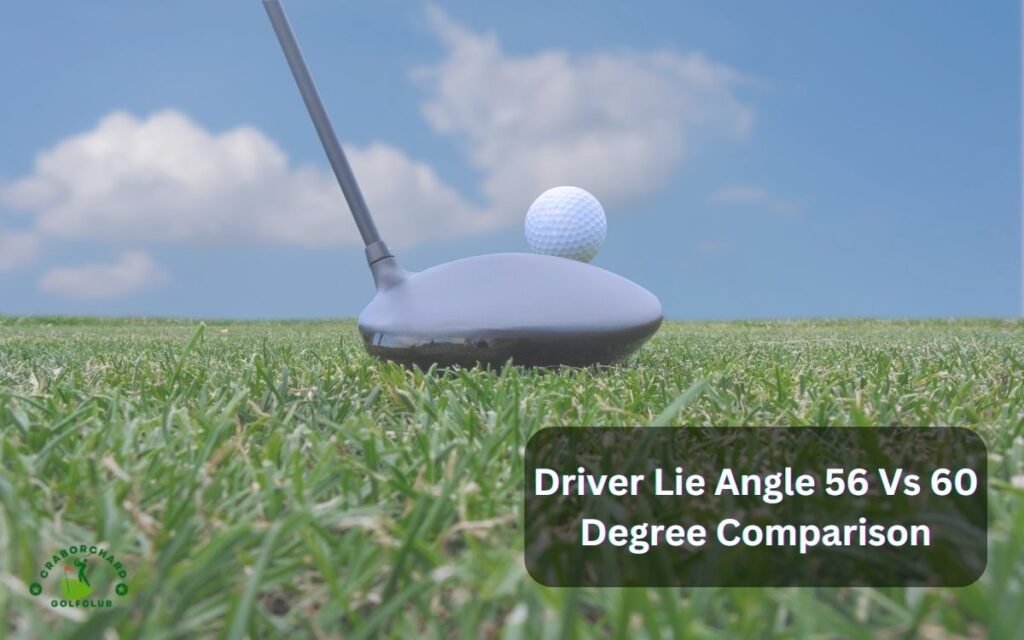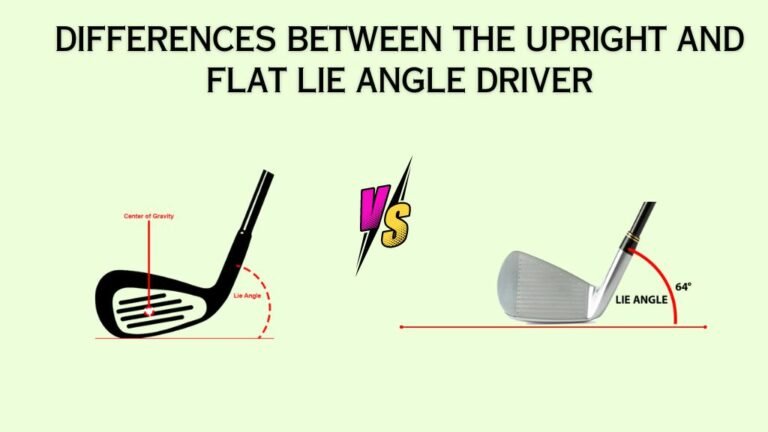Driver Lie Angle 56 Vs 60 Degree Comparison [2024!]
The accuracy of each swing may make the difference between an experienced and beginner golfer. With two commonly used lie angles, which driver lie angle is superior, 56 or 60 degrees?
This post will also go through the lie angle problem. It will assist you in determining the best setup to maximize the possibilities of your swing. Follow this comprehensive driver lie angle 56 vs 60 guide to choose the right driver lie angle for you.

Distinctions between the Driver Lie Angle 56 Vs 60
The table below provides a quick comparison of the 56 and 60 driver lie angles depending on a variety of criteria:
| S.L | Factor | 56-Degree Lie Angle | 60-Degree Lie Angle |
|---|---|---|---|
| 1. | Control | Flatter clubface, promotes accuracy, and tighter shot dispersion | Slightly closed clubface, potential impact on accuracy |
| 2. | Trajectory | Lower launch angle, flatter ball flight | Higher launch angle, potential for increased carry distance |
| 3. | Shot Shaping | Neutral shot shape, versatile for fades and draws | Encourages draws, more closed clubface at impact |
| 4. | Swing Path | Compatible with neutral or slightly inside-out swing paths | Aids players with outside-in swing paths |
| 5. | Course Condition | Enhanced accuracy, suitable for tight fairways | Higher launch and spin, beneficial for wide and soft conditions |
| 6. | Bunker | Flatter clubface, suitable for opening the face | Closed face, versatile for low bunker shots |
| 7. | Comfort and Feel | Subjective feel during swing and impact | Subjective feel |
| 8. | Skill Level | Forgiveness and control for beginners and high handicappers | Shot-shaping benefits for experienced golfers |
| 9. | Shaft Length | Suitable for shorter shafts and moderate swing speeds | Suitable for longer shafts and higher swing speeds |
The variations between driver lie angles that are 56 and 60 rely on a variety of factors. These distinctions are described in detail below:
1. Control
The driver’s lie angle of 56 degrees encourages a more upright stance. It enables golfers to use a flatter clubface to strike the ball. So, the launch angle is reduced, the backspin is increased, and the accuracy is improved.
Golfers with a more vertical swing path may find that a lie angle of 56 degrees is more suited to their game. It promotes more consistent ball striking and finer shot distribution.
The 60-degree lie angle encourages a somewhat more closed clubface. It can help you get a better launch trajectory. Golfers who struggle to get the ball airborne may benefit from this additional loft.
It also helps if you need more backspin for more stopping power. The trade-off might be decreased shot accuracy.
The 56-degree lie angle is the superior option if accuracy and control are your primary goals. Its flatter clubface at impact is more forgiving in general and provides more consistency in ball flight for a broader variety of players.
2. Trajectory
The 60-degree lying angle has the ability to excel in terms of trajectory and distance. It facilitates a higher launch angle with a closer clubface. Increased carry distance off the tee may result from this.
The 60-degree lie angle may be helpful for golfers who struggle to create enough height to maximize distance.
A lower launch angle is often produced with a lie angle of 56 degrees. A flatter, more penetrating ball flight may come from this.
This configuration can offer the appropriate trajectory for players whose natural ball flight is higher. Additionally, it enables greater roll-out on the fairways.
Ultimately, the 60-degree lie angle can be a better fit for your game if you emphasize increasing distance. Additionally, it aids in raising the ball higher.
3. Shot Shaping
To move the ball from right to left or from left to right, shot shape is essential. The more neutral shot form is often encouraged by the 56-degree lie angle. Golfers can now more easily perform both fades and draws thanks to this.
The clubface is balanced between being closed and being open. It offers flexible shot shaping options.
The closed face position of the 60-degree lie angle may help to draw naturally. This stance may be advantageous for players who like to shape their strokes from the right to the left.
This is so because a right-to-left spin axis is encouraged by the closed face.
The 56-degree lie angle may be more advantageous owing to its neutral setup for golfers looking to be able to work the ball in many directions. However, the 60-degree lie angle can be a better option if you wish to promote draws.
4. Swing Path
The 56-degree lie angle is usually more forgiving. Such swing actions are complemented by the clubface’s flatter profile upon impact. The number of unnecessary cuts or hooks is reduced.
The 56-degree lying angle may yield better outcomes and reduce mishits for golfers who have a fairly consistent swing path.
The 60-degree is more comfortable for players whose outside-in swing path is more pronounced. The clubface’s closed design could prevent cuts and promote a straighter ball trajectory.
For golfers who have trouble with fades or blocks, it also helps with a delicate draw. However, the closed face may increase hooks if your swing path is already somewhat neutral.
The 56-degree lie angle can be preferable if your swing path tends to be on the straighter side or little inside-out. The 60-degree lie angle may aid in straightening your strokes.
5. Course Condition
The increased accuracy and control of the 56-degree lie angle may be helpful to golfers who commonly play on narrow fairways. It also helps with numerous hazards when traversing difficult course layouts.
Golfers who play on courses with large fairways and soft terrain could benefit from the 60-degree lie angle. On soft grass, the increased launch and added backspin might assist the ball go farther and stop more quickly.
Your choice between the 56-degree and 60-degree lie angles may be influenced by the type of courses you play as well as course circumstances.
6. Bunker
Greenside bunkers could perform better with a lie angle of 56 degrees. This makes it simple for you to open the face and make high, soft shots.
For some bunker shots, the closed face of the 60-degree lie angle might be favorable. This is particularly true when you need to keep the ball low so that it releases more forcefully when it lands.
Your bunker play may be impacted by the lying angle of your driver. The 60-degree lie angle may be preferred by players who play in bunkers with solid, compacted sand. This is because of its adaptability in these conditions.
7. Comfort and Feel
Note how each lying angle feels during swing and impact during testing or fitting sessions. A more comfortable and natural angle may result in more frequent strikes with the 56 degree angle.
Despite the 56 degree angle’s technical benefits, the 60 degree angle may offer a greater overall performance.
While the technical components of lie angle are important, it’s also important to think about your comfort level. Your performance can be considerably impacted by having faith in the lie angle of your equipment.
8. Skill Level
The forgiveness and control that the 56-degree lie angle offers may be very helpful to beginners and players with high handicaps.
They may be able to create a sound swing with its more neutral setting. As they work on their game, accuracy also becomes better.
The 60-degree lie angle offers shot-shaping possibilities and possible distance increases.
The advantages of the closed clubface may be efficiently utilized by players who frequently have a better awareness of their own swing habits.
The optimal lie angle is also influenced by a golfer’s experience and ability level. The 60 degree lie angle may appeal to more seasoned players, especially those with lower handicaps.
9. Shaft Length
The 56-degree lie angle may produce better outcomes for golfers who use a shorter driver shaft and have a moderate swing speed. The flatter clubface encourages precision and restraint.
For golders that value precision and consistency over raw distance, it may be helpful.
For golfers with longer driver shafts and faster swings, a lie angle of 60 degrees could be preferable.
The closed clubface can reduce the risk of slicing and give the clubhead more time to square up upon impact. Straighter shots are the outcome of this.
The effectiveness of various lie angles can be influenced by the length of the driver shaft. To identify the setup that best accentuates your swing characteristics, try out various shaft length and lie angle combinations.
in our verdict Driver Lie Angle 56 Vs 60
As you play, keep in mind that your own preferences and swing attributes will determine which of the two lie angles is ideal for you.
To find the optimal lying angle that fits your individual game, you must seek the advice of a professional club fitter.



